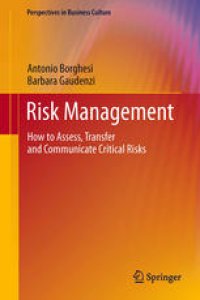
Ebook: Risk Management: How to Assess, Transfer and Communicate Critical Risks
- Tags: Production/Logistics/Supply Chain Management, Business Strategy/Leadership, Law and Economics, Financial Economics, Management/Business for Professionals, Insurance
- Series: Perspectives in Business Culture
- Year: 2013
- Publisher: Springer-Verlag Mailand
- Edition: 1
- Language: English
- pdf
The increasingly risky environment in which companies operate is characterized by a rising number of risk components, factors, sources, and drivers. The identification, evaluation, and management of these risks require the capability to coordinate various skills within a company and in upstream and downstream relationships. This handbook provides an integrated approach to the assessment, transfer, and communication of critical risks and highlights emerging methodologies that can help to protect businesses from adverse events and their effects. It explains how different risk management perspectives should be combined, and in particular how the corporate governance vision should be integrated with the perspectives of operations management, financial management, and business continuity management. In this sense the handbook provides concrete directions on how to develop a risk management team and culture, taking into account business challenges and employing appropriate managerial tools.
The increasingly risky environment in which companies now operate is characterized by a rising number of risk components, factors, sources, and drivers. Risk exists at various levels, both inside the company and at the network level. The identification, evaluation, and management of these risks require the capability to coordinate various skills within a single company and in upstream and downstream relationships.
This handbook provides an integrated approach to the assessment, transfer, and communication of critical risks and highlights emerging methodologies that can effectively and efficiently help to protect businesses from adverse events and their effects. It explains how different risk management perspectives should be combined, and in particular how the corporate governance vision should be integrated with the perspectives of operations management, financial management, and business continuity management. In this sense the handbook provides concrete directions on how to develop a risk management team and culture, taking into account business challenges and employing appropriate managerial tools.
The increasingly risky environment in which companies now operate is characterized by a rising number of risk components, factors, sources, and drivers. Risk exists at various levels, both inside the company and at the network level. The identification, evaluation, and management of these risks require the capability to coordinate various skills within a single company and in upstream and downstream relationships.
This handbook provides an integrated approach to the assessment, transfer, and communication of critical risks and highlights emerging methodologies that can effectively and efficiently help to protect businesses from adverse events and their effects. It explains how different risk management perspectives should be combined, and in particular how the corporate governance vision should be integrated with the perspectives of operations management, financial management, and business continuity management. In this sense the handbook provides concrete directions on how to develop a risk management team and culture, taking into account business challenges and employing appropriate managerial tools.
Content:
Front Matter....Pages i-x
Front Matter....Pages 1-1
From Social and Natural Science Comes a Historical Overview on the Concepts of Uncertainty and Risk....Pages 3-8
Governance and Risk Management....Pages 9-17
Risk Management Perspectives....Pages 19-28
Front Matter....Pages 29-29
The Need for an Enterprise-Wide Approach to Risk Management....Pages 31-42
Risk Identification....Pages 43-52
Risk Analysis....Pages 53-85
Front Matter....Pages 87-87
Risk Treatment....Pages 89-113
Front Matter....Pages 115-115
Operational Risk and Supply Chain Risk Management....Pages 117-137
Erratum to: Risk Management....Pages E1-E1
The increasingly risky environment in which companies now operate is characterized by a rising number of risk components, factors, sources, and drivers. Risk exists at various levels, both inside the company and at the network level. The identification, evaluation, and management of these risks require the capability to coordinate various skills within a single company and in upstream and downstream relationships.
This handbook provides an integrated approach to the assessment, transfer, and communication of critical risks and highlights emerging methodologies that can effectively and efficiently help to protect businesses from adverse events and their effects. It explains how different risk management perspectives should be combined, and in particular how the corporate governance vision should be integrated with the perspectives of operations management, financial management, and business continuity management. In this sense the handbook provides concrete directions on how to develop a risk management team and culture, taking into account business challenges and employing appropriate managerial tools.
Content:
Front Matter....Pages i-x
Front Matter....Pages 1-1
From Social and Natural Science Comes a Historical Overview on the Concepts of Uncertainty and Risk....Pages 3-8
Governance and Risk Management....Pages 9-17
Risk Management Perspectives....Pages 19-28
Front Matter....Pages 29-29
The Need for an Enterprise-Wide Approach to Risk Management....Pages 31-42
Risk Identification....Pages 43-52
Risk Analysis....Pages 53-85
Front Matter....Pages 87-87
Risk Treatment....Pages 89-113
Front Matter....Pages 115-115
Operational Risk and Supply Chain Risk Management....Pages 117-137
Erratum to: Risk Management....Pages E1-E1
....